Japan
Tna: Yappari Nihon ni kaechatta (Finally we're coming back to Japan)... Tsukareta (how tired)...
Kaoko: Waaah... the scenery is sugooooi (great) ~! I like this city!
Hano: Are? Futari tomo koko ni ikenakatta ato de (you both never been here before)?
Tna, Kaoko: Hano-kun?
 Doushite anata koko ni (why are you here)?
Doushite anata koko ni (why are you here)?Hano: Hai, hai (yes, yes)... so iueba (come to think of it)... you both always go travelling around Japan, but never asked me to join. Urayamashii na ore (I envy you)...

Tna: Haha gomen, gomen (sorry, sorry)... shikatanai yo (that can't be helped), Hano-kun... we're doing it for our classroom...
Kaoko: Hai, hai... just like Tna-chan says...
Hano: Mou ii. C'mon, let's explore the city!
Kaoko: Chotto, chotto, Hano-kun... we're not going to travel around Nagano City this time, but we're gonna meet up with Uehara Yui-san...
Hano: Uehara Yui-san? Aitsu wa dare da (who is that person)?
Tna: A police detective from Nagano Police Districts. She's in charged of today's lesson...
Hano: Keiji-san (a police detective)? Naze darou (why)?
Kaoko: Ii kara hayaku ikimashou~!
Uehara Yui's Residence
Nagano City, Nagano Prefecture
Japan
Yui: Youkoso, youkoso (welcome, welcome)... o-suwatte douzo (please have a seat)...
Tna, Kaoko, Hano: Arigatou gozaimasu~!
Tna: Tonikaku, Yui-san... kore wa Hano-kun, mo Nihongo kyoushitsu no membaa desu (this is Hano-kun, also a member of Japanese classroom)...
Hano: Yoroshiku...

Yui: Yoroshiku~ By the way, you're going to know about Japanese Tea Ceremony right?
Kaoko: Hai, sou desu ne...
Tna: O-mendo moshiwake arimasen (sorry for causing any trouble), Yui-san...
Yui: Daijoubu yo~ Tasukete ureshiikatta ne... Maa, Japanese Tea Ceremony or usually called the Way of Tea or Sadoo in Japanese, is a Japanese cultural activity influenced by Zen Buddhism, involving the ceremonial preparation and presentation of matcha (powdered green tea) and ceremonially prepared by a skilled practitioner and served to a small group of guests in a tranquil setting...
Matcha
Yui: Tea gatherings are classified into two, ochakai (お茶会) and chaji (茶事). Ochakai or chakai is a relatively simple course of hospitality that includes the service of confections, thin tea (薄茶 usucha), and perhaps a light meal, while chaji is a more formal gathering, usually with a full-course meal (kaiseki), followed by confections, thick tea (濃茶 koicha), and thin tea. A chaji will likely last at least four hours...
Hano: Thin tea and thick tea?
Yui: Yeah. Those are two main ways of preparing matcha in tea ceremony. koicha (thick tea) is a thick blend of matcha and hot water that requires about three times as much tea to the equivalent amount of water than usucha (thin tea). To prepare usucha, matcha and hot water are whipped using the tea whisk (茶筅 chasen), while koicha is kneaded with the whisk to smoothly blend the large amount of powdered tea with the water...
Koicha
Usucha
Yui: Nah, the most important of chaji is the preparation and drinking of koicha, which is followed by usucha. A chakai may involve only the preparation and serving of thin tea (and accompanying confections), representing the more relaxed, finishing portion of a chaji...
Tna: Soukka... so, is there any special season for doing this ceremony? And... where do the ceremony usually take place?
Yui: Traditionally the year is divided by tea practitioners into two main seasons; the sunken hearth (炉 ro) season, constituting the colder months (traditionally November to April), and the brazier (風炉furo) season, constituting the warmer months (traditionally May to October). The ceremony is held whether in indoor (in the tea rooms called chashitsu) and outdoor (usually called nodate)...
Yamato: Chashitsu is a room consisted of 4.5 tatami (mats) or larger eventhough it's also used for general purpose, not only for tea ceremony exclusively...
Chashitsu
Yui: Kan-chan? 

Yamato: Stop calling me like that.
Hano: Who is he again, Kaoko?
Kaoko: He is Yui-san's superior, also police detective... and... her love interest!
Hano: Maji ka yooo (really)?
Kaoko: Sou, sou... but they're just too shy to admit...

Yui: *cough* What are you talking about, Kaoko?

Kaoko: Ahaha... be-be-betsuni (nothing in particular)...
Tna: Sore yori, what kind of equipments used in that tea ceremony?
Yui: Well... tea utensils or usually called chadoogu are the important thing in tea ceremony, like chakin ( (茶巾), tea bowl or chawan (茶碗), tea caddy or natsume (棗), tea scoop or chashaku (茶杓), and tea whisk or chasen (茶筅)...
Yamato: Chakin is a small rectangular white linen or hemp cloth mainly used to wipe the tea bowl...
Chakin
Yui: Tea bowl... you may know about this. Tea bowls have different styles for thick and thin tea. Shallow bowls, which allow the tea to cool rapidly, are used in summer; deep bowls are used in winter...
Tea Bowls
Yamato: Tea caddy, the small lidded container in which the powdered tea is placed for use in the tea-making procedure...
Tea Caddy
Tea Scoop and Tea Whisk
Tna: Ah... you two really well-collaborated... I'm curious of something... 

Kaoko, Hano: That's what's we're discussed before!
Yui, Yamato: Sonna koto ja nai yo (It's not like that)! 

Tna: Maa, maa (well, well)... mou yamenasai (please stop already), Kaoko-chan, Hano-kun, da ga hontou ni korosareru (or else we'll be killed by them)...
Kaoko: Sore wa anata da yo (That's you), Tna-chan... 

Hano: Well, well... tonikaku (by the way), Yui-san, about the tea gathering things... you said the more formal one called chaji or something... what's that? I mean, there's always a procedure in formal thing, so how's the procedure of chaji?
Yui: Yeah, of course. There are many steps in chaji tea ceremony. If the ceremony takes place in chashitsu, initially the guests are waiting at the bench along the roji (bare ground) until summoned by the host...
Roji Niwa
Yui: They ritually purify themselves by washing their hands and rinsing their mouths with water from a small stone basin, and proceed along the roji to the tea house. Guests remove their footwear and enter the tea house through a small door, and proceed to view the items placed in the tokonoma scroll alcove and any tea equipment placed ready in the room, and are then seated seiza-style on the tatami in order of prestige...
Tokonama
Seiza-style
Yui: If a charcoal fire is being used to heat the water, the host will lay the fire in the presence of the guests. Following the laying of the fire, the host then serves the guests a meal in several courses accompanied by sake, followed by a small sweet eaten from special paper called kaishi (懐紙), which each guest carries, often in a decorative wallet or tucked into the breast of the kimono. They will then return to the waiting shelter until summoned again by the host...
Sake
Kaishi
Yamato: The utensils are placed in an exact arrangement according to the particular temae procedure being performed. When the preparation of the utensils is complete, the host prepares thick tea using set movements. When the tea is ready it will either be served to the first guest by an assistant or the guest will retrieve the bowl from the host...
Tna: Sumimasen ga, 'Temae' tte nani? (Sorry, but what's 'Temae'?)
Yui: Temae is the procedure of making tea. There are many types of temae, but I'll explain to you later, soon after we finish with the 'chaji'...
Tna: Hai, roger~!
Yamato: Bows are exchanged between the host and the guest receiving the tea. The guest then bows to the second guest, and raises the bowl in a gesture of respect to the host. The guest rotates the bowl to avoid drinking from its front, takes a sip, and compliments the host on the tea. After taking a few sips, the guest wipes clean the rim of the bowl and passes it to the second guest. The procedure is repeated until all guests have taken tea from the same bowl; each guest has an opportunity to admire the bowl before it is returned to the host, who then cleanses the equipment and leaves the tea room...
Kaoko: Naruhodo (I see)... then?
Yui: If a charcoal fire is being used, the host will then rekindle the fire and add more charcoal. This signifies a change from the more formal portion of the gathering to the more casual portion, and the host will return to the tea room to bring in a smoking set (タバコ盆 tabako-bon) and more confections, usually higashi (干菓子), to accompany the thin tea, and possibly cushions for the guests' comfort...
Tabako-bon
Higashi
Yamato: The host will then proceed with the preparation of an individual bowl of thin tea to be served to each guest. The conversation now is more casual than before...
Yui: Yeah, right, because it's usucha portion so they may engage in conversation each other. After all the guests have taken tea, the host cleans the utensils in preparation for putting them away. The guest of honour will request that the host allow the guests to examine some of the utensils, and each guest in turn examines each item, including the tea caddy and the tea scoop. The host then collects the utensils, and the guests leave the tea house. The host bows from the door, and the ceremony is over. A tea ceremony can last up to four hours, depending on the type of ceremony performed, the number of guests, and the types of meal and tea served...
Tna: Wah, it's kind of a long process... anyway, we must keep sitting in seiza style during the ceremony? No... 

Yui: Yeah, at first you may not get used to it, but as time goes by, it won't be a problem anymore...
Kaoko: Mattaku (geez)... ah, about 'Temae'?
Yamato: There are many styles of temae (点前, also written as 手前), depending upon the occasion, season, and countless other possible factors,. But we'll tell you the four of them. First is Chabako temae. It's so called because the equipment is removed from and then replaced into a special box known as a "chabako" (茶箱, lit. "tea box"). All tea ceremony equipments are put onto it. This ceremony takes approximately 35–40 minutes.
Chabako
Yui: Second is Hakobi-demae. It's so called because, except for the hot water kettle (and brazier if a sunken hearth is not being used), the essential items for the tea-making, including even the fresh water container, are carried into the tea room by the host as a part of the temae...
Yamato: Third, O-Bon temae or Bonryaku. It's a simple procedure for making usucha (thin tea). The tea bowl, tea whisk, tea scoop, chakin and tea caddy are placed on a tray, and the hot water is prepared in a kettle called a tetsubin, which is heated on a brazier...
Bonryaku
Tetsubin
Yui: The fourth is Ryuurei. the tea is prepared with the host seated at a special table, and the guests are also seated at tables. In ryūrei there is usually an assistant who sits near the host and moves the host's seat out of the way as needed for standing or sitting. The assistant also serves the tea and sweets to the guests...
Ryuurei
Yamato: Ah yeah, I forgot telling you. Wearing kimono (Japanese traditional clothing) is a must when attending the tea ceremony, both men and women. We also wear tabi (divided-toe socks).
Kimono Woman
Kimono Man
Tabi
Yui: You already know about "Ikebana" right? Nah, Chabana (茶花, literally "tea flowers") is the simple but elegant style of flower arranging for Japanese tea ceremony. It has its origins in the ikebana style of flower arranging which is in turn firmly seated in both Shinto and Buddhism...
Chabana
Tna: Then... I'm still curious of the scrolls hung in the tokonama...
Yamato: Oh those scrolls? Well. They are selected for their appropriateness for the occasion, including the season and the theme of the particular get-together. Calligraphic scrolls may feature well-known sayings, particularly those associated with Buddhism, poems, descriptions of famous places, or words or phrases associated with tea ceremony...
Yui: A typical example of a hanging scroll in a tea room might have the kanji 和敬清寂 (wa-kei-sei-jaku, lit. "harmony", "respect", "purity", and "tranquility"), expressing the four key principles of the Way of Tea. Some contain only a single character; in summer, 風 (kaze, lit. "wind") would be appropriate...
Kaoko: And.. what kind of meal served during the tea ceremony?
Yui: That's called 'Cha-kaiseki'. The basic constituents of a cha-kaiseki meal are the ichijū sansai or "one soup, three side dishes", and the rice, plus the following: suimono (clear soup), hassun, yutō, and kō no mono. The one soup referred to here is usually miso soup, and the basic three side dishes are mukozuke, nimono (simmered vegetables), and yakimono...
Suimono
Hassun
Yuuta
Kō no mono
Miso Soup Tofu
Mukoozuke
Nimono
Yakimono
Yamato: Sore wa ijou, Nihongo no sadoo no koto. Any question? Or pretty clear?
Tna: Hai, wakatte ita yo dakedo (Yeah, I understood but)...
Yui: Nani ga atta (What's up)?
Tna, Kaoko: Onaka ga suitaaaa (we're hungry)~ 

Hano: Ore mo (me too)... hara heta (I'm hungry)...
Yui: Ara! Chotto matte kudasai (please wait)...
Tna, Kaoko, Kaoko: Haai...
Twenty minutes later...
Yui: Hai, douzo...
Yui: This is gohei-mochi, one of Nagano regional food. Made from rice flour. Grilled with a sauce of miso and walnuts (kurumi)... tabemashou, minna, tabemashou~ I'm going to bring you another dish, o-chotto...
Tna: Wah~ I've never seen it before... umm... just like grilled senbei...
Kaoko: I thought so too~
Yui: Chaan~ douzo!
Yui: This is 'Koiryouri', carp dish. Carp is cut in rings and pickled in Shinshu miso paste. Then simmered for a long time in miso paste. A kind of carp soup...
Hano: Looks delicious!
All: Itadakimasu~!
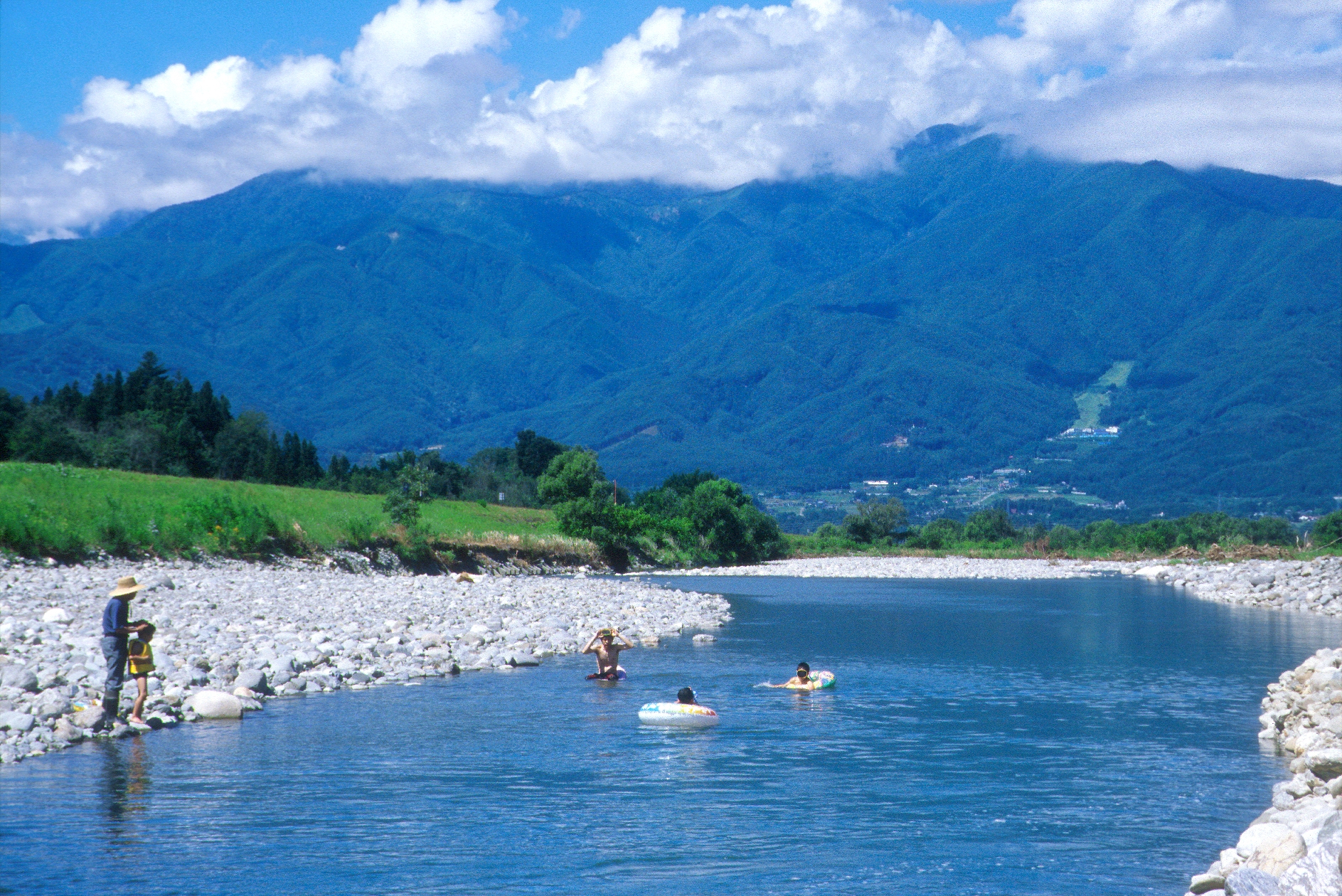




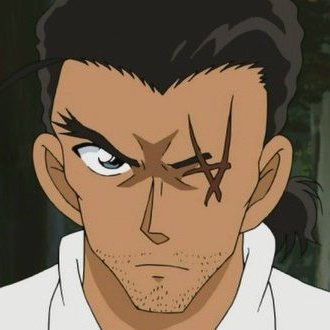

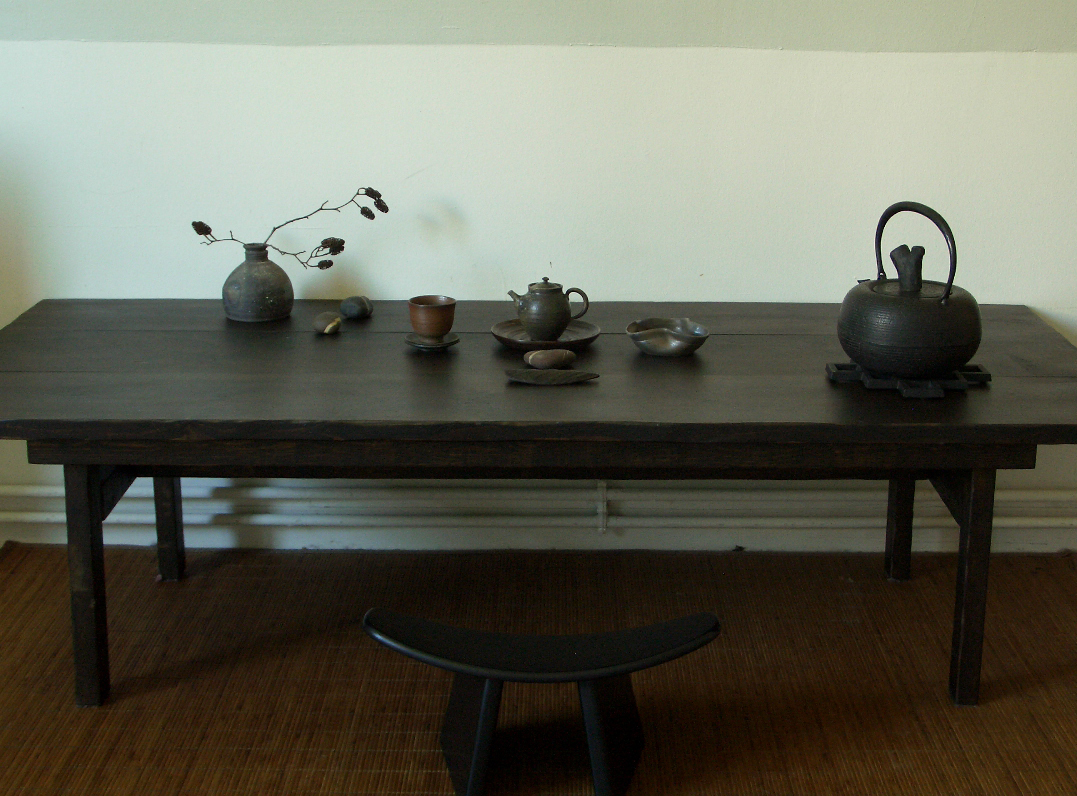
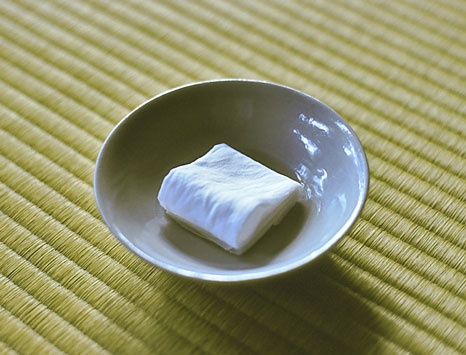



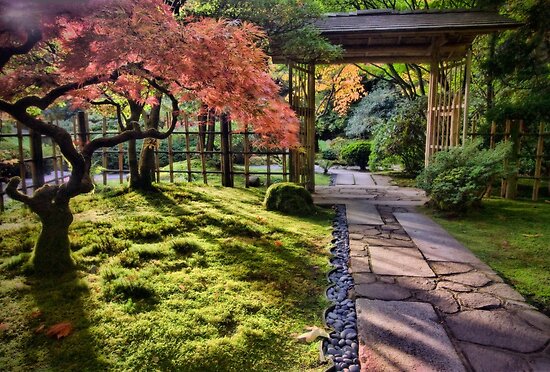




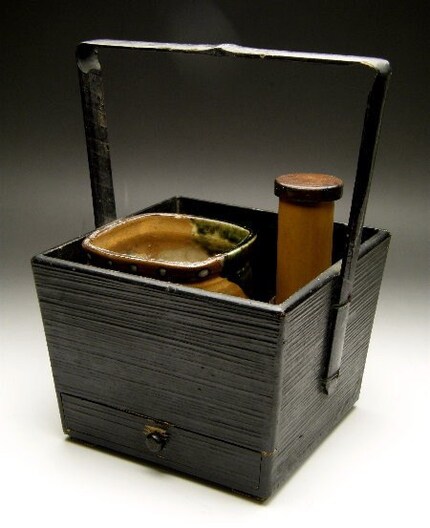




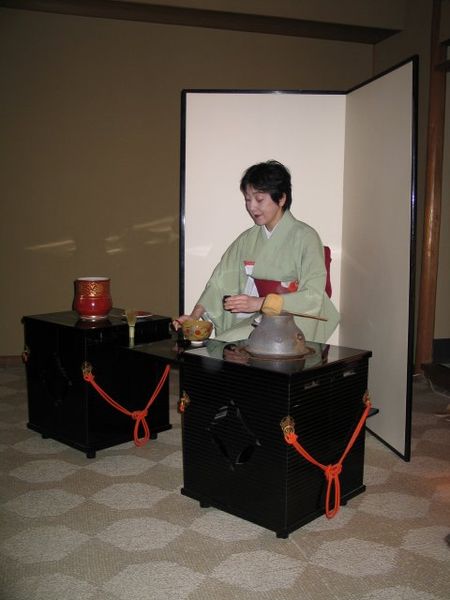





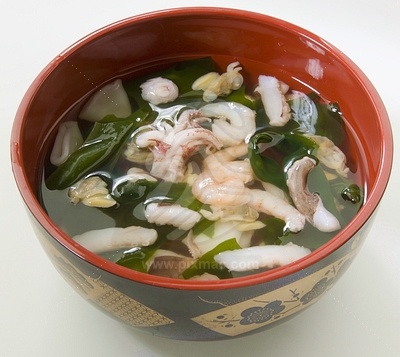
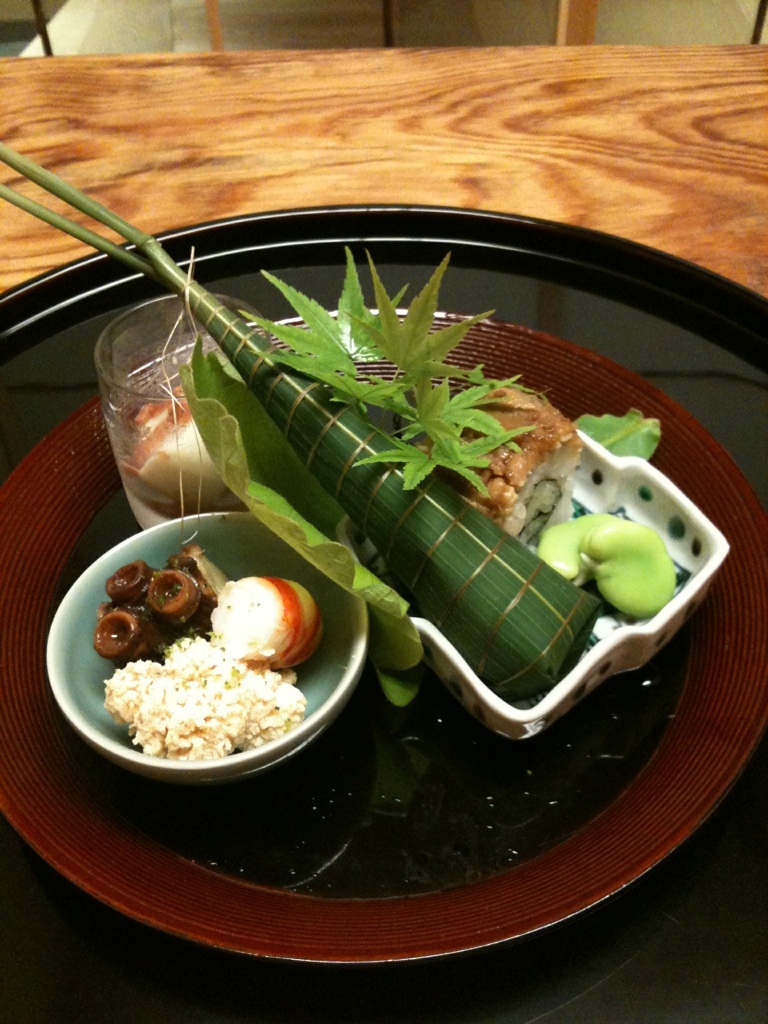


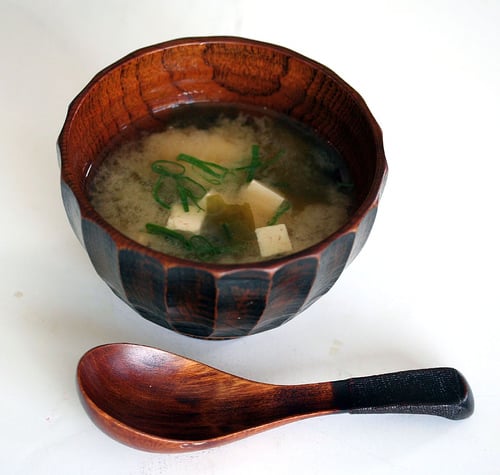
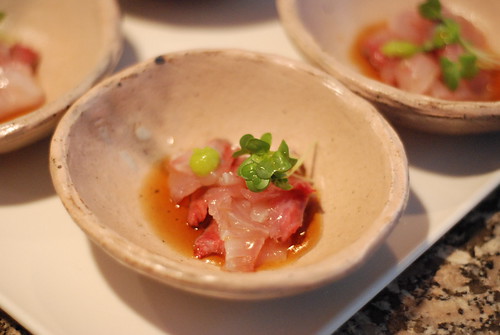

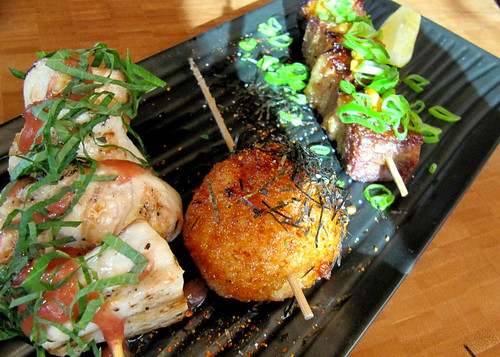


No comments:
Post a Comment